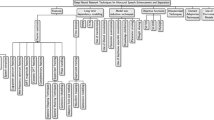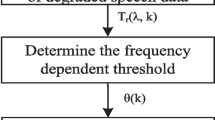Abstract
Many on-line blind audio source separation (BASS) algorithms have been presented so far to the scientific community, but only a few of them have been evaluated in terms of their real-time performance. In this paper we consider a well-established BASS method (oriented to voices separation) evaluating its performance in terms of separation quality allowed by a real-time embedded computing implementation, also considering novel and state-of-the-art improvements to the it. To this aim, the algorithm has been implemented and ported for real-time execution onto an advanced low-power digital signal processor targeted for complex-domain applications. The optimized embedded implementation is able to perform up to five iterations of the gradient for any input frame of data, achieving good separation levels (up to 11.8 dB of signal to interference ratio on custom recording in real environments). The proposed solution doubles the performance of a C-optimized version running on a traditional PC processor, achieving a better separation result with lower power requirements.










Similar content being viewed by others
References
Parra L, Spence C (2000) On-line blind source separation of non-stationary signals. J VLSI Signal Process 26:39–46
Aichner R, Buchner H, Araki S, Makino S (2003) On-line time-domain blind source separation of non stationary convolved signals. In: Proceedings of the international symposium on independent component analysis blind signal separation (ICA), pp 987–992
Murata N, Ikeda S (1998) An on-line algorithm for blind source separation on speech signals. In: Proceedings of the NOLTA’98
de Laar JV, Habets E, Peters J, Lokkart P (2001) Adaptive blind audio signal separation on a DSP. In: Proceedings on the workshop circuits, systems and signal processing (ProRISC), Veldhoven, The Netherlands, pp 475–479
Mukai R, Sawada H, Araki S, Makino S (2004) Blind source separation for moving speech signals using blockwise ICA and residual crosstalk subtraction. IEICE Trans Fundam E87-A(8), 131–138
Mukai R, Sawada H, Araki S, Makino S (2005) Real-time blind source separation and DOA estimation using small 3-D microphone arrays. In: Proceedings of the IWAENC 2005, Eindhoven, pp 45–48
Aichner R, Buchner H, Yan F, Kellermann W (2004) Real-time convolutive blind source separation based on a broadband approach. In: Proceedings of the IEEE international symposium on independent component analysis and blind source separation (ICA), pp 840–848
Asano F, Ikeda S (2000) Evaluation and real-time implementation of blind source separation system using time-delayed decorrelation. In: Proceedings of the second international workshop on ICA and BSS, pp 411–415
Muceli S, Pani D, Raffo L (2008) Non-invasive real-time fetal ECG extraction: a block-on-line DSP implementation based on the JADE algorithm. In: Proceedings of the BIOSIGNALS 2008, international conference on bio-inspired systems and signal processing, vol 2, Funchal, Madeira, Portugal, pp 458–463
Pani D, Barabino G, Raffo L (2012) NInFEA: an embedded framework for the real-time evaluation of fetal ECG extraction algorithms. Biomedizinische Technik/Biomed Eng 58(1):13–26
Meloni P, Secchi S, Raffo L (2010) An FPGA-based framework for technology-aware prototyping of multicore embedded architectures. IEEE Embed Syst Lett 2(1):5–9
Charoensak C, Sattar F (2005) A single-chip FPGA design for real-time ICA-based blind source separation algorithm. In: Proceedings of the IEEE international symposium on circuits and systems (ISCAS), vol 6, pp 5822–5825
Torkkola K (1996) Blind separation of convolved sources based on information maximization. In: Proceedings of the 1996 IEEE signal processing society workshop on neural networks for signal processing, pp 423-432
Celik A, Stanacevic M, Cauwenberghs G (2004) Mixed-signal real-time adaptive blind source separation. In: Proceedings of the 2004 international symposium on circuits and systems (ISCAS), vol 5, pp V-760–V-763
Patil D, Das N, Routray A (2011) Implementation of Fast-ICA: a performance based comparison between floating point and fixed point DSP platform. Meas Sci Rev 11(4):118–124
Hyvarinen A, Oja E (1997) A fast fixed-point algorithm for independent component analysis. Neural Comput 9:1483–1492
Berset T, Geng D, Romero I (2012) An optimized DSP implementation of adaptive filtering and ICA for motion artifact reduction in ambulatory ECG monitoring. In: Proceedings of the annual international conference of the IEEE engineering in medicine and biology society (EMBC), pp 6496–6499
Bai YW, Yeh CH (2009) Design and implementation of a remote embedded DSP stethoscope with a method for judging heart murmur. In: Proceedings of the international instrumentation and measurement technology conference (I2MTC), Singapore, pp 1580–1585
Erten G, Salam FM (1997) Real time separation of audio signals using digital signal processors. In: Proceedings of the 40th midwest symposium on circuits and systems, vol 2, pp 1237–124
Mori Y, Saruwatari H, Takatani T, Ukai S, Shikano K, Hiekata T, Ikeda Y, Hashimoto H, Morita T (2006) Blind separation of acoustic signals combining SIMO-model-based independent component analysis and binary masking. EURASIP J Adv Signal Process 2006:034970
Oliva-Moreno LN, Moreno-Cadenas JA, Flores-Nava LM, Gomez-Castaneda F (2006) DSP implementation of extended infomax ICA algorithm for blind source separation. In: Proceedings of the 3rd international conference on electrical and electronics engineering, pp 1–4
Hiekata T et al (2009) Development and evaluation of pocket-size blind source separation microphone. Acoust Sci Technol 30(4):297–304
Comon P (1994) Indipendent component analysis, a new concept? Signal Process 36:287–314
Ikram M, Morgan D (2000) Exploring permutation inconsistency in blind separation of speech signals in a reverberant environment. In: Proceedings of the IEEE international conference on acoustics, speech, signal processing, pp 1041–1044
Ikram M, Morgan D (2005) Permutation inconsistency in blind speech separation: Investigation and solution. IEEE Trans Speech Audio Process 13(1):1–13
Araki S, Makino S, Nishikawa T, Sarawatary H (2001) Fundamental limitation of frequency domain blind source separation for convolutive of speech. In: Proceedings of the ICASSP, pp 2737–2740
Ikram M, Morgan D (2002) A beamforming approach to permutation alignment for multichannel frequency-domain blind speech separation. In: Proceedings of the IEEE international conference on acoustics, speech, signal processing, pp 881–884
Murata N, Ikeda S, Ziehe A (1998) An approach to blind source separation based on temporal structure of speech signals. Tech. rep, RIKEN Brain Science Institute, Japan
Parra L, Spence C (2000) Convolutive blind separation of non-stationary source. IEEE Tran Speech Audio Process 8(3):320–327
Sawada H, Mukai R, Araki S, Makino S (2003) A roboust approach to the permutation problem of frequency-domain blind source separation. In: Proceedings of the ICASSP, pp 381–384
Sawada H, Mukai R, Araki S, Makino S (2004) A robust and precise method for solving the permutation problem of frequency-domain blind source separation. IEEE Trans Speech Audio Process 12(5):530–538
Nishikawa T, Saruwatari H, Shikano K, Araki S, Makino S (2003) Multistage ICA for blind source separation of real acoustic convolutive mixture. In: Proceedings of the 4th international symposium on ICA and BSS
Nishikawa T, Saruwatary H, Shikano K (2002) Comparison of time-domain ICA, frequency-domain ica and multistage ICA for blind source separation. In: Proceedings of the EUSIPCO2002, vol 2, pp 15–18
Parra L, Spence C, Vries BD (1998) Convolutive blind source separation based on multiple decorrelation. In: Proceedings of the workshop on neural networks and signal processing, Cambridge, UK
ATMEL Corporation (2004) DIOPSIS 740 dual-core DSP AT572D740. 7001ADPS09/04
ATMEL Corporation (2004) JTST AT572D740-DK1 user manual. 7003ADPS11/04
ATMEL Corporation (2005) MADE user guide. 7004ADPS05/05
ATMEL Corporation (2005) DSP library—user manual (draft). DRAFT-DPS-12/05
Mitra SK (2002) Digital signal processing, a computer-based approach, 2nd edn. McGraw Hill International Edition, New York
Parra L Blind source separation based on multiple decorrelations. http://bme.ccny.cuny.edu/faculty/lparra/publish/bss/index.html. Accessed 30 June 2007
Fancourt C, Parra L (2002) A comparison of decorrelation criteria for the blind source separation of nonstationary signals. In: Proceedings of the sensor array and multichannel signal processing workshop, pp 418–421
Ikram M, Morgan D (2001) A multiresolution approach to blind separation of speech signals in a reverberant environment. In: Proceedings of the IEEE international conference on acoustics, speech, signal processing, pp 2757–2760
Amari S (1998) Natural gradient works efficiently in learning. RIKEN Frontier Research Program
Amari S, Cichocki A, Yang H (1996) A new learning algorithm for blind signal separation. Adv Neural Inf Process Syst 8:757–763
Kovacs F, Horvath C, Balogh AT, Hosszu G (2011) Fetal phonocardiography—past and future possibilities. Comput Methods Progr Biomed 104(1):19–25
Vaisman S, Salem SY, Holcberg G, Geva AB (2012) Passive fetal monitoring by adaptive wavelet denoising method. Comput Biol Med 42(2):171–179
Romano M, Cesarelli M, D’Addio G, Mazzoleni M, Bifulco P, Ferrara N, Rengo F (2010) Telemedicine fetal phonocardiography surveillance: an Italian satisfactory experience. Stud Health Technol Inform 155:176–181
Acknowledgments
The authors wish to thank Dr. Gianmarco Angius for his help with the realization of the recording setup and the sound engineers Matteo Bucca and Carla Pisano for their kind help and the useful suggestions.
Author information
Authors and Affiliations
Corresponding author
Rights and permissions
About this article
Cite this article
Pani, D., Pani, A. & Raffo, L. Real-time blind audio source separation: performance assessment on an advanced digital signal processor. J Supercomput 70, 1555–1576 (2014). https://doi.org/10.1007/s11227-014-1252-4
Published:
Issue Date:
DOI: https://doi.org/10.1007/s11227-014-1252-4




